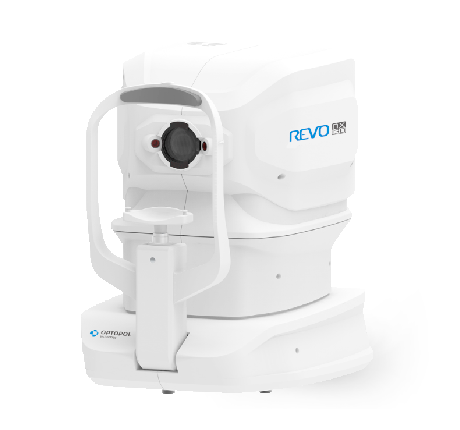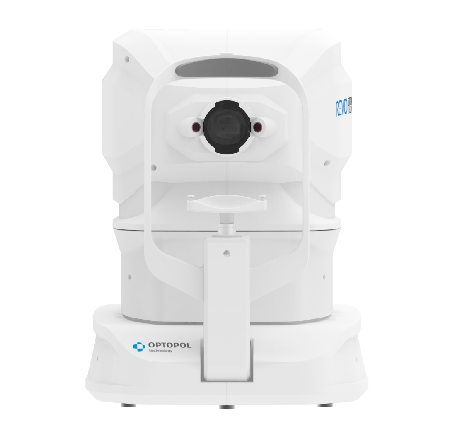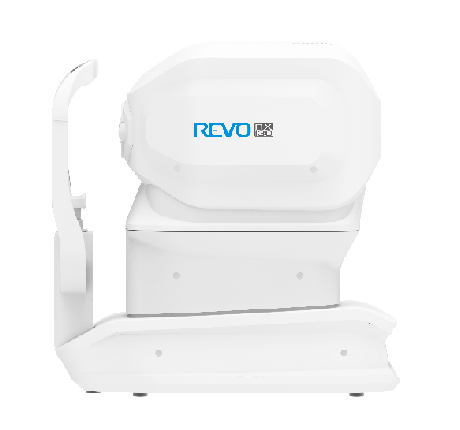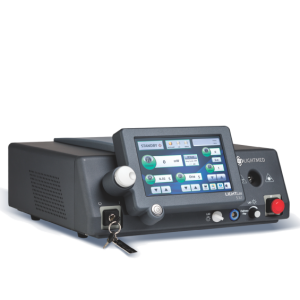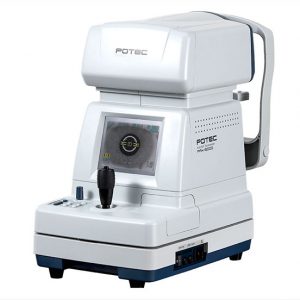Description
New OCT standard – All functionality In One device.
Once again Revo NX goes beyond the limits of standard OCT. With its new scanning speed, our Revo NX 130 enables a full functionality scanning from the retina to the cornea. It brings benefits by combining the potential of several devices. With REVO you can measure, quantify, calculate and track changes from the cornea to the retina over time with just one OCT device.
i Tracking™
iTracking™ technology compensates involuntary eye movements and blinks. When OCT scan is used each anatomical region is acquired twice automatically. The system immediately creates an artifactfree MC examination using the Motion Correction TechnologyTM. The elimination of eye movement and blinking artifacts ensures the highest resolution of Angio OCT images without patient inconvenience. Clear OCTA data set allows easier interpret retina vasculature condition.
AI DENOISE
Improved tomogram quality powered by Artificial Intelligence. Advanced AI algorithms enhance the quality of a single tomogram to the level of an averaged tomogram obtained through multiple scanning.
FULL RANGE
New Extended DepthTM Retina imaging, based on our Full Range technology, provides scans of increased depth for reliable and convenient observation of challenging cases. With scans presenting plenty of depth, this new imaging mode is perfect for diagnosing even highly myopic patients.
RETINA
Single 3D Retina examination is enough to perform both Retina and Glaucoma analysis based on retinal scans. Software automatically recognize 8 retina layers. Thus allowing a more precise diagnosis and mapping any changes in the patient’s retina condition.
|
Single
|
Both |
| Comparison |
FOLLOW UP
High density of standard 3D scan allows to precisely track the disease progress. Operator can analyze changes is morphology, quantified progression maps or evaluate the progression trends.
Precise registration
The software can track 3D scans and register them to the OCT baseline exam by recognizing patterns in the shape of blood vessels. Active tracking and post-processing point-to-point registration allows the user to precisely see and track the changes in retina morphology in Comparison and Progression analysis.

COMPARISON
Comparison view allows in easy and convince way to review results from two visits. The view is available for most of the scan programs.
GLAUCOMA
Comprehensive glaucoma analytical tools for quantification of the Nerve Fiber Layer, Ganglion layer and Optic Head with DDLS allow for the precise diagnosis and monitoring of glaucoma over time.
With the golden standard 14 optic nerve parameters and a new Rim to Disc and Rim Absence the description of ONH condition is quick and precise.
Advanced view which provides combined information from Retina and Disc scan to integrate details of the Ganglion cells, RNFL, ONH in a wide field perspective for comprehensive analysis.
| Advance Retina & ONH | ONH Single |
 |
 |
Asymmetry Analysis of Ganglion layers between hemi-spheres and between eyes allows easier identification and detection of glaucoma in early stages and in non-typical patients.
| Ganglion Both | Ganglion Progression |
 |
 |
Implemented the DDLS – Disc Damage Likelihood Scale which use 3 separate classification for small, average and large discs. It supports the practitioners in a quick and precise evaluation of the patient’s glaucomatous disc damages.
| ONH Both | ONH Progression |
 |
 |
COMPLET YOUR GLAUCOMA REPORT
To eliminate common problem with the understanding of the patient’s IOP pachymetry module provides IOP Correction value. With the implemented Adjusted IOP formula you can quickly and precisely understand the measured IOP value.
As the Pachymetry and Anterior Chamber Angle Verification require no additional attachments, the predefined Glaucoma protocol, which consists of Retina, Disc and Anterior scans, can be done automatically to reduce patient chair time.
| Closing angle | Anterior Radial Single View Cornea |
 |
 |
| Full Range Anterior Chamber single view | |
| * Images curtesy of Edward Wylęgała, MD, PhD | |
COMPREHENSIVE GLAUCOMA SOLUTION
STRUCTURE & FUNCTION – Combined OCT and VF results analysis
Invaluable combination of information about the functional quality of vision with comprehensive data on retinal Ganglion Cells, RNFL and Optic Nerve Head for both eyes on a single report page. The S&F report contains the following:
- VF sensitivity results (24-2/30-2 or 10-2)
- Total and Pattern Deviation probability graphs for VF results
- Reliability and Global indices for VF results
- Combined map of Structure & Function
- Ganglion cell analysis (GCL+IPL or NFL+GCL+IPL)
- ONH and NFL analysis including charts and comparison tables
- NFL Asymmetry Plot
The S&F report compares in a natural way the anatomical relationship between VF and RNFL/Ganglion maps.
SINGLE PAGE REPORT
S+F provides a quick and comprehensive single page report for glaucoma management.
ANTERIOR CHAMBER
Additional adapter provided with the device allows the user to perform the imaging of the anterior segment. Now you can display the whole anterior segment or focus on a small area to bring out the details of the image.
Anterior Chamber exam with a fast view of the whole Anterior Chamber make the evaluation of gonioscopy situation and the verification of cataract lens easier and faster.
| Full Range Anterior Chamber | |
 |
|
| Full Range Lens | |
 |
ANTERIOR SEGMENT
For standard examinations no additional lens is required. Additional adapter provided with the device allows to make wide scans of anterior segment.
| Cornea both | |
| Cornea Comparison | Cornea Progression |
NETWORKING
A proficient networking solution increases productivity and an enhanced patient experience. It allows you to view and manipulate multiple examinations from review stations in your practice. Effortlessly helping to facilitate patient education by allowing you to interactively show examination results to patients. Every practice will have differing requirements which we can provide by tailoring a bespoke service. There is no additional charge for the server module.
DICOM
Store, exchange, and transmit results through DICOM gateway to the hospital network.
OCT ANGIOGRAPHY is optional software module to purchase
This optional software module allows visualization of the retinal microvasculature. Angiography SOCT is a non-invasive, dye-free technique providing 3D image of retinal blood circulation.
Software allows to observe, track and compare changes in the microvasculature of the retina in both eyes.
| Standard Single View | |
 |
|
| Both View | |
 |
|
ANGIO ANALYISIS METHODS
QUANTIFICATION
The quantification tool provides quantification of the vasculature in the whole analyzed area together with values in specific zones and sectors. Thanks to the heat map of the analyzed vasculature the evaluation of vascular structure conditions is much faster. The choice of the quantification method increases the sensitivity of analyses for specific deseases.
Available quantification methods:
- Vessel Area Density – it is defined as the total area of perfused vasculature per unit area in a region of measurement.
- Skeleton Area Density – it is defined as the total area of skeletonized vasculature per unit area in a region of measurement.
Quantification is available for a specific layer in Angio OCT exam:
- Retina: Superficial Plexus and Deep Plexus
- Disc: RPC – Radial Peripapillary Capillary
ANGIO-ANALYTICAL TOOLS
FAZ – Foveal Avascular Zone measurements enable the quantification and monitoring of changes in Superficial and Deep vascular layers. The FAZ tool is also available for narrow and wide scans.
 |
|
| FAZ Area [mm2] Perimeter [mm] Circularity |
VFA – Vascular Flow Area allows the user to examine the pathologically affected area and to precisely measure the area covered by vascularization.
The simple and easy area measurement can be performed on a predefined or user-selected vascular layer.
NFA – Non Flow Area measurement tool makes it possible to quantify the Non Flow Area on the OCT Angio examination. It provides the sum of all marked areas.
ANGIO MOSAIC
The Angiography mosaic delivers high-detailed images over large field of the retina.
Advanced tab provides: view of any vascular layers, enface view of vascular layers, depth coded and thickness map. Mosaic modes: 10×6 mm, 12×5 mm, 7×7 mm, 10×10 mm and Manual (up to 12 images).
BIOMETRY OCT is optional software module to purchase
B-OCT® is an innovative method of using the posterior OCT device to measure ocular structure along eye axis.
OCT Biometry provides a complete set of Biometry parameters: Axial Length AL, Central Cornea Thickness CCT, Anterior Chamber Depth ACD, Lens Thickness LT, Pupil size P and White to White WTW.
The B-OCT® module is available in two options:
- Standard Biometry module:
- High myopia management
- Axial distance measurement
- IOL Calculator
- IOL lens editor
- IOLcon.org support
The standard version of the module broadens the functionality of the device with the addition of the IOL Tab which allows the user to calculate the lens power of a selected IOL model (on the basis of the patient’s morphological data).
- Basic Biometry module:
- High myopia management
- Axial distances measurement
- No IOL Calculator
- Optometrist dedicated module
The basic B-OCT® module provides an exceptional comfort of daily use.
| Analysis window |
Visually verify your measurement
All measurement calipers are shown on the all boundaries OCT image provided by REVO. Now, you can visually verify and correct what structure of the eye has been measured.
IOL CALCULATOR
IOL formulas allow the user to calculate IOL implant parameters. Our systems now support the latest IOL data base standard IOLCon.org so that you can always keep your library up-to-date.

TOPOGRAPHY OCT is optional software module to purchase
T-OCT™ is a pioneering way to provide detailed corneal Curvature maps by using posterior dedicated OCT. Ante-rior, Posterior surface and Corneal Thickness allow to provide the True Net Curvature information. With Net power, the precise understading of the patient’s corneal condition comes easily and is free of errors associated with modelling of posterior surface of the cornea. SOCT T-OCT module provides Axial maps, Tangential maps, Total Power map, Height maps, Epithelium and Corneal thickness maps.
Corneal topography module clearly shows the changes in the cornea on the difference map view. Customize your
Topography module provides:
- Full featured Corneal mapping of Anterior, Posterior and Real
- Precise Astigmatism Display Option (SimK: Anterior, Posterior, Real, Meridian and Emi-Meridian ø 3, 5, 7 mm zones
KERATOCONUS SCREENING
Easly detect and classified keratoconus with Keratoconus classifier. Classification based on KPI, SAI, DSI, OSI and CSI. In the early stages of kera-toconus the results can be complemented by Epithelium and Pachymatery maps.
| Normal | Astigmatysm | Keratoconus |
 |
COMPARE THE TOPOGRAPHY EXAMS
Comprehensive software features a range of selectable views: Single, Both. See details on standard Singe view and easly see corneal asymmetry on the Both view.
The follow-up feature in to the T-OCT™ module, allows fully compare the changes in the corneal topography over time for:
- LASIK undergone patients
- Keratoconus patients
- The contact lens wearers
| Single | |
 |
|
| Comparison | Progression |
ANGIOGRAPHY
PDR, Angio Mosaic mode: 10×10 mm

*Images courtesy of Bartosz L. Sikorski MD, PhD
ANTERIOR

Anterior scan, Cornea Guttata with corneal scaring

* Images courtesy of Prof. Edward Wylęgała MD, PhD


